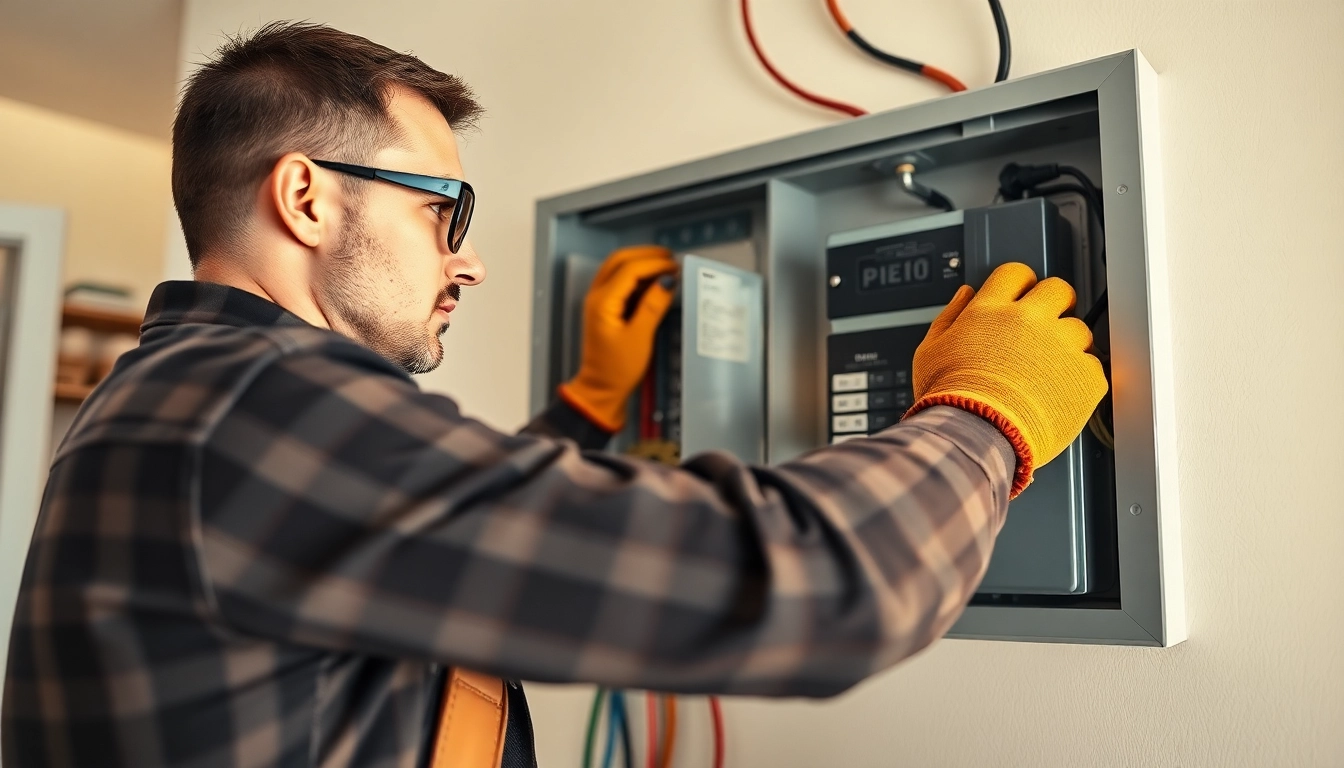Introduction to Electrical Panel Upgrades
When it comes to maintaining a safe and efficient home, one aspect that often goes unnoticed is the electrical panel. The Electrical Panel Upgrade is an essential consideration for homeowners, especially in an era of increasing electrical demands and advancements in technology. Upgrading your electrical panel can not only enhance your home’s electrical efficiency but also improve its safety and functionality. This article will delve into the nitty-gritty of electrical panel upgrades, exploring their necessity, benefits, costs, and the steps to successfully navigate the upgrading process.
What is an Electrical Panel Upgrade?
An electrical panel, also known as a breaker box or service panel, is the hub of your home’s electrical system. It distributes power from the utility company to various circuits throughout your home, ensuring a consistent and safe supply of electricity. An electrical panel upgrade involves replacing an outdated panel with a newer, more capable model. This upgrade often includes the installation of a panel with a higher amperage, which can accommodate more circuits and deliver greater electrical capacity.
Why Upgrading Your Electrical Panel is Essential
As our reliance on electrical devices continues to grow—from kitchen appliances and heating systems to home entertainment setups and electric vehicles—the demand for electricity in our homes has increased significantly. Many older homes were designed with electrical systems that may not support today’s usage, making upgrades essential for safety and efficiency. Upgrading your electrical panel ensures that your home can handle the required power safely without causing circuit overloads, tripped breakers, or, in extreme cases, electrical fires.
Common Signs Indicating the Need for an Upgrade
- Frequent Tripped Breakers: If you find yourself frequently resetting breakers or dealing with blown fuses, it could indicate that your panel isn’t equipped to handle your electrical load.
- Old or Damaged Equipment: If your electrical panel is over 20 years old or shows signs of rust, wear, or damage, it’s a good indicator that an upgrade is necessary.
- Renovations or Additions: If you’re planning to add new appliances, convert a basement into living space, or include an electric vehicle charger, an upgrade may be essential.
- Inadequate Amperage: Homes that originally had a 60-amp service or even 100-amp service often require a higher capacity (usually 200 amps) for modern electrical needs.
Benefits of Upgrading Your Electrical Panel
Increased Electrical Capacity and Performance
One of the most significant advantages of upgrading your electrical panel is the boost in electrical capacity. Modern panels typically offer higher amperage, allowing more devices and circuits to be powered simultaneously without overloading the system. For example, if you upgrade from a 100-amp to a 200-amp panel, you can safely increase the number of circuits available to accommodate additional appliances and devices, ultimately resulting in improved performance and convenience.
Enhanced Safety Features in Modern Panels
Modern electrical panels come equipped with enhanced safety features that are designed to protect your home and family. These panels include better circuit breakers that can quickly detect overloads, short circuits, and ground faults. New safety protocols, such as GFCI (Ground Fault Circuit Interrupter) and AFCI (Arc Fault Circuit Interrupter) breakers, can prevent electrical shock and reduce the risk of fires caused by faulty wiring. By upgrading your electrical panel, you are investing not only in capacity but also in a safer living environment.
Long-term Cost Efficiency and Savings
While upgrading an electrical panel may seem like a significant upfront expense, the long-term savings can be substantial. Newer panels are designed to be more energy-efficient, which can lead to reduced electricity bills. Furthermore, with fewer circuit overloads and malfunctions, you will likely spend less on repairs and replacements for appliances that might suffer from inadequate power supply. Additionally, in areas where rebates and tax credits apply for electrical upgrades, homeowners can offset some of the initial costs.
Factors Influencing the Cost of Electrical Panel Upgrades
Average Cost Estimates for Different Upgrades
The costs associated with upgrading an electrical panel can vary widely based on several factors, including the type of panel, location, and complexity of the installation. Generally, homeowners can expect to spend anywhere from $800 to $4,000 for an electrical panel upgrade. Upgrading from 100 amps to 200 amps typically falls within the range of $1,300 to $3,000. It’s essential to factor in any additional costs for materials, labor, and potential complications that may arise during installation.
Permits and Labor: What to Expect
In most jurisdictions, obtaining a permit is necessary before proceeding with an electrical panel upgrade. This process ensures that all work complies with local electrical codes and safety regulations. Permit fees can add to the overall cost of the upgrade, usually ranging from $50 to $300, depending on where you live. Additionally, labor costs for qualified electricians can vary, with hourly rates typically between $50 and $100. It’s crucial to obtain multiple quotes and choose a licensed, insured professional to ensure quality workmanship.
Available Rebates and Tax Credits for Upgrades
Homeowners can take advantage of various rebates and tax credits that may be available for electrical panel upgrades. Federal and state programs often provide financial incentives, particularly when the upgrades improve energy efficiency or support electric vehicle infrastructure. For example, certain upgrades might be eligible for tax credits of up to $1,200 or $2,000 if completed within specified timeframes. Before proceeding with an upgrade, it’s advisable to research available incentives to help alleviate overall costs.
Step-by-Step Guide to Planning Your Electrical Panel Upgrade
Choosing the Right Electrician for Your Project
Choosing the right electrician is arguably the most critical step in the upgrade process. Start by conducting thorough research, asking for recommendations, and reading online reviews. Look for licensed and insured electricians with experience in panel upgrades. It’s also wise to request and compare multiple estimates, ensuring that all aspects of the job are included in the quoted price. Ask potential electricians about their familiarity with local codes and safety regulations.
Preparing Your Home for the Upgrade Process
Once you have selected an electrician, it’s essential to prepare your home for the upgrade. This may involve clearing the area around the electrical panel, ensuring easy access for electricians. Additionally, notify any family members of the work schedule, as there may be temporary power interruptions. Discuss potential issues or concerns with your electrician during the planning phase to ensure a smooth transition.
What to Expect During the Installation
The installation of a new electrical panel typically takes several hours to a full day, depending on the complexity of the project. Your electrician will begin by disconnecting the power to the old panel, removing it, and installing the new panel. During this time, they will also replace any outdated breakers and make necessary adjustments to wiring. Once the installation is complete, the electrician will conduct tests to ensure everything is functioning correctly before restoring power.
Maintaining Your Electrical Panel After an Upgrade
Routine Inspections and Maintenance Tips
After upgrading your electrical panel, establishing a routine inspection and maintenance schedule is crucial for ensuring ongoing safety and performance. Homeowners should regularly check for signs of wear, such as dimming lights, tripped breakers, or burning odors. Inspect the exterior of the panel for rust or corrosion and ensure that all connections are tight. It’s wise to schedule professional inspections every few years to catch potential issues early.
Signs of Potential Issues to Watch For
Even after an upgrade, remaining vigilant for signs of electrical issues is essential. Be on the lookout for:
- Flickering or dimming lights.
- Burning smells or discolored outlets.
- Circuit breakers that frequently trip.
- Unexplained increases in electricity bills.
- Buzzing sounds from the panel.
If you notice any of these issues, contact a qualified electrician immediately to conduct a thorough inspection.
When to Consult with a Professional Electrician
It’s crucial to understand when to call in a professional electrician. If you’re experiencing significant electrical issues or you have plans to expand your electrical system, consult an electrician to assess your requirements. Additionally, if you’re unsure about performing inspections or maintenance tasks, seek professional assistance to avoid risks or complicating issues further.


